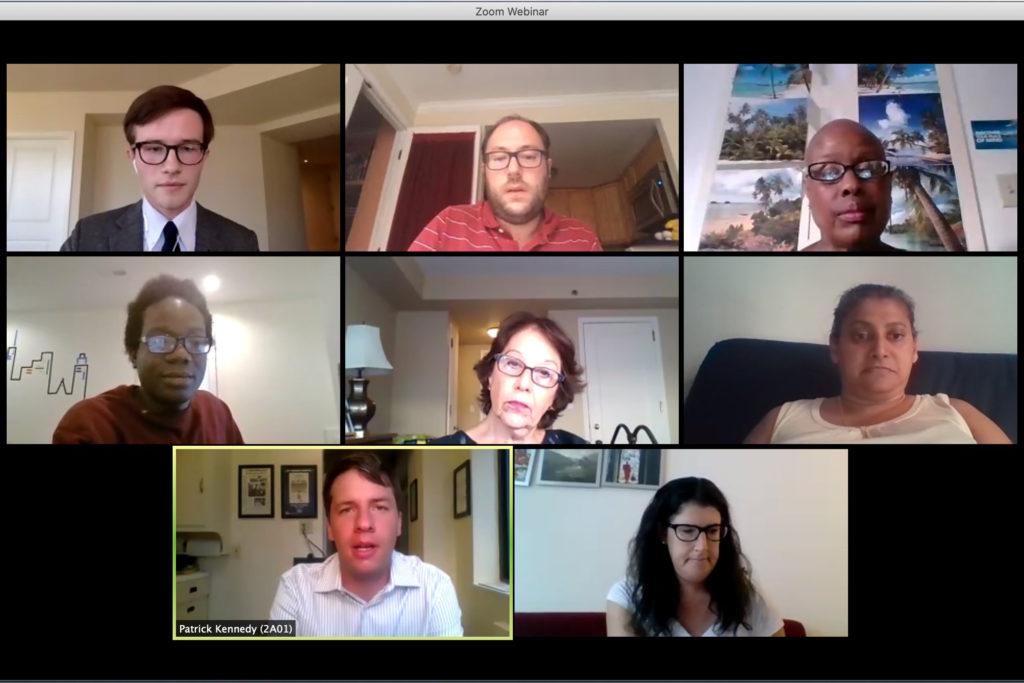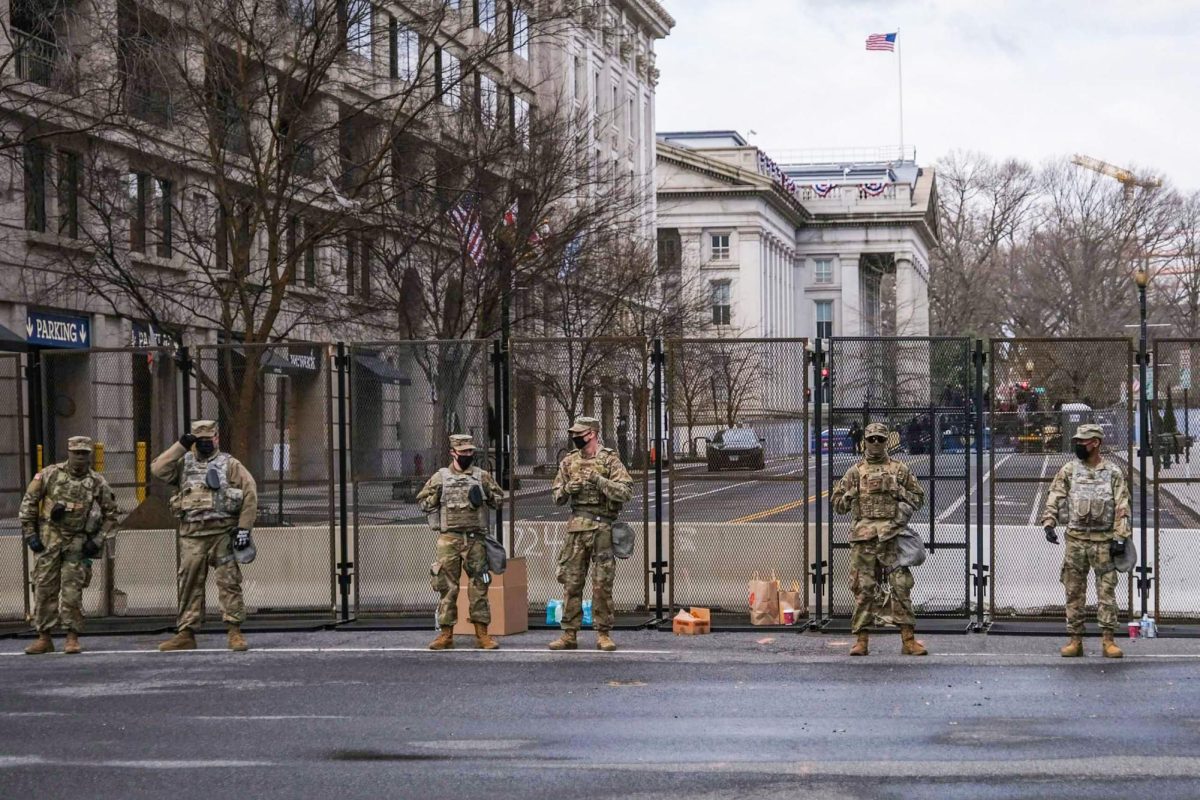A local governing body voted Wednesday to expand a slew of sidewalks on campus to allow students, faculty, staff and neighbors to socially distance when walking outdoors.
The Foggy Bottom and West End Advisory Neighborhood Commission passed a resolution to install sidewalk extensions in seven locations and construct two “street cafes” on campus to enable better social distancing in public spaces. The vote comes as the neighborhood prepares for the University to reopen and usher in a wave of thousands of new pedestrians who will congest Foggy Bottom’s streets and sidewalks – which a recently posted map suggests are currently in no shape for social distancing.
Among other measures passed unanimously, commissioners voted to install a new protected bike lane on two stretches of 20th and 21st streets and elected senior James Harnett as the commission’s next chair – the youngest person ever elected to serve at the top post of any ANC in D.C. history.
Here are the meeting’s highlights:
Sidewalk extensions
Commissioners voted to recommend the D.C. Department of Transportation extend multiple sidewalks spread across the University’s campus to give pedestrians extra room to stay six feet apart when walking through the neighborhood. Harnett said the extensions may take up both sides of some streets on campus, but none of the spaces will obstruct any nearby traffic lane, only parking lanes.
The extensions would progress the length of H, G and F streets for three blocks between 20th and 23rd streets, passing by student hubs like Kogan Plaza, the Marvin Center, University Yard and the Lerner Health and Wellness Center, according to a map displayed at the meeting. The map shows the expanded sidewalks continue through 21st and 22nd streets starting at I Street, stopping at F Street on 21st and reaching Virginia Avenue on 22nd.
Expanded walkways also include extensions in front of the Elliott School of International Affairs and the Shops at 2000 Penn in addition to added space on the 500 block of 20th Street between the Elliott School and The York Apartments.
[gwh_image id=”1123052″ credit=”Courtesy of James Harnett” size=”embedded-img” align=”none” /]
“Almost all sidewalk locations in Foggy Bottom are inadequate for people passing each other to remain six feet apart, and so that’s obviously a great concern to both the neighborhood and the students that live in this area,” Harnett said.
A map an alumnus posted earlier this year shows that the majority of walkways on campus are unfit for social distancing, often measuring less than 14 feet wide. City officials started to expand a few sidewalks back in April, but critics have said that the makeshift extensions fell short in creating sufficient space for social distancing.
Harnett said he expects the extensions to take the form of bollards – short posts used to block off bike lanes or other car-free zones. He said DDOT officials told him the bollards can range anywhere from plastic posts draped with caution tape to “immovable” rails that would provide extra protection to local passersby.
The resolution includes plans to provide “parklets,” extra parking spaces, designated for additional restaurant seating for both Tonic and Duke’s Grocery. Harnett said the area will give businesses the ability to move their services outdoors so guests will be able to dine with less risk of spreading the coronavirus.
“One of the things we’ve noticed in the pandemic is that it’s incredibly important that outdoor seating be available for restaurant operations to help stop the spread of the virus,” Harnett said.
Mayor Muriel Bowser announced plans in April to permit businesses to share streets with restaurants and pedestrians and construct “streateries” that expand outdoor seating onto sidewalks and even parking and travel lanes. Harnett said the outdoor seating on campus would fill the parking lanes in front of Tonic and Duke’s Grocery but will leave nearby traffic lanes untouched.
Harnett said the resolution would also require officials to install a pick-up and drop-off zone outside of Whole Foods, which would allow people to access the grocery store and avoid cars parked outside throughout the day.
The commission adopted an amendment to the resolution proposed by Commissioner Patrick Kennedy, who said the recommendation to DDOT should designate room on F Street for additional “curbside spaces” that would provide parking space for residents living in nearby apartments like The Statesman, the Letterman House, Empire House or The York Apartments.
The commission’s resolution states city officials would start to install the proposed extensions Aug. 17.
Protected bike lanes
The commission approved plans to install protected bike lanes on campus, running through 20th and 21st streets.
Cynthia Lin, a transportation planner for DDOT, said the proposed protected bike lanes stretch down 20th Street from Massachusetts Avenue to G Street. The protected lanes turn onto G Street and continue south on 21st until reaching Constitution Avenue, Lin said.
Lin said DDOT officials will construct a lane on the south side of G Street, an 11-foot-wide space on the east side of 21st Street and a lane measuring about 14 feet on the west side of 20th Street, according to a slide Lin presented at the meeting. Another of the presentation’s slides showed construction would take place in “mid-fall.”
A new chairperson
Commissioners unanimously elected Harnett to serve at the ANC’s top post for the remainder of the 2020 term. Harnett said he will be the youngest ANC chair in the District’s history.
Harnett, who has served on the commission since his sophomore year and will graduate this winter, said he will not run for reelection during the fall elections. Harnett will succeed Kennedy, who stepped down as chair last month while retaining his commissioner role.
The commission also unanimously elected Commissioner Nicole Goldin to serve as secretary following Commissioner Detrick Campbell’s announcement that he would resign from the ANC at the end of July. Campbell said he is preparing to move residences so he will no longer be able to represent his constituents who predominantly make up the west side of GW’s campus.







